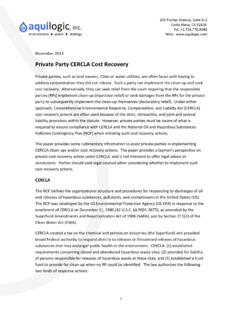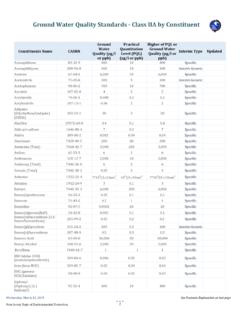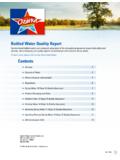Transcription of Petroleum Contamination - Aquilogic
1 Email: Telephone: + Petroleum Contamination The Contamination Experts Responsible Party Identification GIS and Geomatics Contaminant Hydrogeology Fate and Transport Modeling Risk Assessment Remediation Feasibility Studies Soil and Groundwater Remediation Natural Resource Damage Assessment Water Resources Assessment Source Water Assessment and Protection Drinking Water Treatment Environmental Risk Management Litigation Support/Expert Witness Forensic Engineering Stakeholder/Public Participation Regulatory Strategy To contact us, or sign up for our newsletter, please scan here. Email: Telephone: + environment water strategy environment water strategy environment water strategy environment water strategy Molecular weight Boiling Point Density Vapor Pressure Sorption (Log Koc) Log Kow Solubility Henry's Constant Regulatory Levels Chemical Type Compound (g/mol) ( C) (g/cm3) (mmHg) (unitless) (unitless) (mg/L) (unitless) CA PHG ( g/L) CA MCL ( g/L) US MCL ( g/L) Aromatic VOCs Benzene 95 1,770 1/NS 5 Toluene 111 530 150 150 1000 Ethylbenzene 136 169 300 300 700 O-Xylene 144 178 1800 1750 10,000 PAHs Napthalene 218 - 170 (AL) - Benzo(a)
2 Pyrene 495 Benz(a)anthracene 438 - - Benzo(b)fluoranthene 481 - - Benzo(k)fluoranthene 480 - - Chrysene 448 - - Fuels Gasoline ~100 40-200 - 50 - - - Kerosene and Jet Fuel ~160 150-250 - 120 - - - Diesel #2 ~200 250-350 - 520 - - - Fuel and Mineral Oils ~270 >150 - 4900 - - - Lead-Alkyl Additives 1,2-DCA 8,700 5 EDB 129 11 4,320 TEL 84 - 15 - Oxygenates MTBE 249 48,000 13 13/5* 20-40 TBA Miscible - 12 (AL) NS TAME 4,295 13 5* NS ETBE 5,031 13 5* NS DIPE 2,666 - NS NS Methanol 122 Miscible - NS NS Ethanol Miscible - NS NS Process Sulfolane 285 8370 - (AK) - Properties of Common Petroleum Contaminants PHG = public health goal MCL = maximum contaminant level AL = action level AK = Alaska * = secondary MCL Fuel carbon range equivalents for property estimation: Gasoline = C6-8; Kerosene = C10-12; Diesel #2 = C12-16.
3 Fuel Oils = C16-C35 Petroleum Contamination Contamination of soil and groundwater can result during all phases of Petroleum production, transmission, refining, storage and marketing. The contaminants include the constituents of crude oil, oil field chemicals ( produced water/brines, diluent, drilling fluids, arsenic biocide), refined products ( gasoline), product additives ( lead-alkyl additives or oxygenates), or other chemicals used in the processing of Petroleum ( sulfolane). Crude oil and the major refined products ( gasoline, kerosene, diesel #2, aviation fuels) are a mixture of hundreds of individual chemicals, notably paraffins (straight chained hydrocarbons), iso-paraffins (branched hydrocarbons), cyclo-hexanes (single-bond, ring hydrocarbons), aromatic hydrocarbons (with a single benzene-ring), and poly-aromatics hydrocarbons (PAHs).
4 Crude oil also contains trace heavy metals, notably nickel, vanadium, copper, cadmium and lead, and naturally occurring radioactive materials (NORMs), notably radium 226 and 228. Sour-oil/gas also contains high concentrations of sulfur. Refined Petroleum products, notably gasoline, usually contain other additives, such as fuel oxygenates ( MTBE, ethanol) and proprietary detergents. Historically, leaded gasoline contained lead-alkyl additives ( tetra-ethyl lead) and anti-knock agents, such as 1,2-dichloroethane (1,2-DCA) and ethylene dibromide (EDB). Most paraffins, iso-paraffins and cyclo-hexanes have low solubility in water, are relatively immobile in the environment, and have limited toxicological effects.
5 However, aromatics and PAHs have higher solubility in water, are somewhat mobile in the environment, and have known toxicological impacts at relatively low concentrations. The aromatics of primary concern are the volatile organic compounds (VOCs) benzene, toluene, ethylbenzene and xylenes (BTEX). The PAHs of primary concern are napthalene, chrysene, benzo(a)pyrene, benz(a) anthracene, benzo(b) fluoranthene, benzo(k)fluoranthene. Most fuel oxygenates have higher solubility and are generally more mobile and persistent in the environment. In particular, MTBE and TBA releases can result in significant groundwater Contamination and impact to water supplies.
6 The anti-knock agents 1,2-DCA and EDB also have relatively high solubility and are also more mobile and persistent in the environment. Aside from pure Petroleum product found as a light non-aqueous phase liquid (LNAPL), BTEX, PAHs, lead-related additives and fuel oxygenates are the most common chemicals found in soil and groundwater at Petroleum facilities. copyright Aquilogic , Inc. 2013




